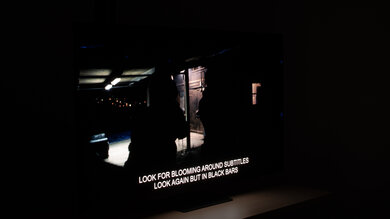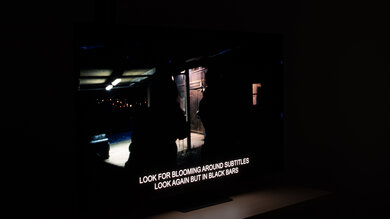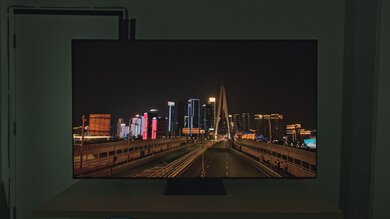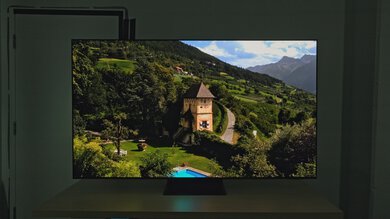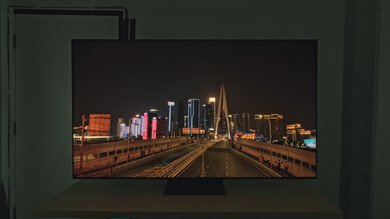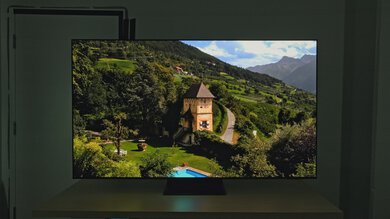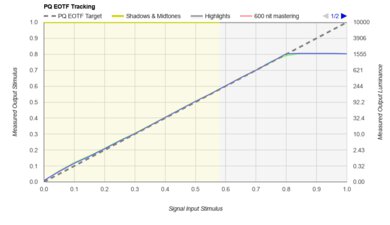The Samsung S95D OLED is Samsung's flagship 4k TV for 2024. It replaces the Samsung S95C OLED and sits above the Samsung S90D/S90DD OLED. Like its predecessor, it uses Samsung's unique Slim One Connect Box to house its inputs. It has the same features as last year's model but adds a new one called Auto AI mode, which uses AI technology to automatically adjust the picture settings based on the genre of game it detects. It's the first OLED to use a matte screen finish that promises a nearly glare-free viewing experience in a bright room. The TV has 70W 4.2.2 channel speakers built-in, uses the 2024 version of the Tizen OS, and supports HDR10+ and Dolby Atmos. It's available in three sizes: 55-inch, 65-inch, and 77-inch.
Our Verdict
The Samsung S95D is an amazing TV for any usage. It's an excellent TV for watching movies in a dark room due to its remarkable contrast and excellent HDR brightness, but it's also excellent for watching shows or sports in a bright room due to its amazing reflection handling and great SDR brightness. The TV's nearly instantaneous response time delivers clear motion, and its incredibly low input lag provides a responsive experience, so it's outstanding for playing video games in SDR and HDR or for use as a PC monitor. It's also a great option if you watch shows or sports with friends due to its incredibly wide viewing angle.
-
Near-infinite contrast ratio for perfect blacks with no blooming around bright highlights.
-
Incredibly wide viewing angle for a consistent image from the sides.
-
Great SDR peak brightness and amazing reflection handling makes it suitable for a bright room.
-
Colors are vibrant, bright, and lifelike.
-
Excellent HDR peak brightness that makes highlights pop.
-
Aggressive ABL can be distracting with large areas of brightness.
The Samsung S95D is excellent for watching TV shows. The TV has great SDR peak brightness and amazing reflection handling due to its matte coating, so it easily overcomes glare in a bright room, but the matte coating does make blacks look gray in a room with the lights on. Its incredibly wide viewing angle means you can freely move around your room while watching TV since the image doesn't degrade when viewed from the sides. The built-in Tizen OS is loaded with streaming apps, so it's easy to find the newest TV shows you want to watch. The TV has very good low-resolution upscaling and does a decent job smoothing out low-quality content, so it's a good choice if you watch DVDs or low-quality streams.
-
Incredibly wide viewing angle for a consistent image from the sides.
-
Great SDR peak brightness and amazing reflection handling makes it suitable for a bright room.
-
Aggressive ABL can be distracting with large areas of brightness.
The Samsung S95D is amazing for watching sports. It has an incredibly wide viewing angle, so it's a fantastic choice for watching the game with friends, as the image doesn't degrade when viewed from the sides. The TV has great SDR brightness and amazing reflection handling due to its matte coating, so it easily overcomes glare in a bright room. However, the TV's contrast greatly decreases, and blacks look gray in a room with the lights on. Motion is crisp due to the TV's nearly instantaneous response time, so there's no blur behind quick-moving players and objects, and its superb uniformity means you won't be distracted by the dirty screen effect when watching sports with large areas of uniform color, like hockey and football.
-
Incredibly wide viewing angle for a consistent image from the sides.
-
Superb gray uniformity with no noticeable dirty screen effect.
-
Great SDR peak brightness and amazing reflection handling makes it suitable for a bright room.
-
Nearly-instantaneous response time for no noticeable blur behind fast motion.
-
Aggressive ABL can be distracting with large areas of brightness.
The Samsung S95D is outstanding for playing video games. The TV's great SDR brightness and amazing reflection handling make it suitable for playing games in a bright room since it easily overcomes glare, although the matte coating does cause the image to look washed out when used in a room with the lights on. There's no noticeable blur behind fast motion due to the TV's nearly instantaneous response time, and its incredibly low input lag delivers a response gaming experience with no noticeable delay between your controller inputs and the action on screen. Enabling Game Mode doesn't majorly impact image quality, so you don't have to worry about trading picture quality for the best performance. Finally, the TV supports up to 4k @ 144Hz with VRR, so it's a fantastic choice to pair with modern gaming consoles or gaming PCs.
-
HDMI 2.1 bandwidth on all four ports.
-
Incredibly low input lag for a very responsive experience.
-
Great SDR peak brightness and amazing reflection handling makes it suitable for a bright room.
-
Nearly-instantaneous response time for no noticeable blur behind fast motion.
-
Aggressive ABL can be distracting with large areas of brightness.
The Samsung S95D is excellent for watching movies in a dark room. Its remarkable color volume and exceptionally wide color gamut deliver vibrant, lifelike, and bright colors. The TV looks spectacular in a dark room due to its remarkable contrast and incredible black uniformity, so blacks are deep and inky with no blooming when bright highlights are on screen. Highlights in HDR content really pop due to the TV's excellent HDR brightness, delivering an impactful HDR experience. It automatically removes 24p judder from any source, so movies are free of judder regardless of how you watch them. The TV has good SDR pre-calibration accuracy, so the image is accurate enough for most people, but if you want the TV to be as accurate as possible, you'll need to get it calibrated.
-
Near-infinite contrast ratio for perfect blacks with no blooming around bright highlights.
-
Removes 24p judder from any source.
-
Colors are vibrant, bright, and lifelike.
-
Excellent HDR peak brightness that makes highlights pop.
-
No Dolby Vision support.
-
Noticeable stutter due to the TV's fast response time.
-
Aggressive ABL can be distracting with large areas of brightness.
-
No DTS Audio support.
The Samsung S95D is fantastic for playing video games in HDR. The TV's remarkable contrast provides deep and inky blacks and highlights in HDR games really stand out due to its excellent HDR brightness. It supports up to 4k @ 144Hz, so it's an excellent choice to pair with modern consoles or gaming PCs. It also supports VRR for a nearly tear-free gaming experience, and motion is clear with no noticeable blur due to its nearly instantaneous response time. The TV has incredibly low input lag, so you get a responsive gaming experience with no noticeable delay between your controller inputs and what happens on screen.
-
Near-infinite contrast ratio for perfect blacks with no blooming around bright highlights.
-
HDMI 2.1 bandwidth on all four ports.
-
Incredibly low input lag for a very responsive experience.
-
Nearly-instantaneous response time for no noticeable blur behind fast motion.
-
Colors are vibrant, bright, and lifelike.
-
Excellent HDR peak brightness that makes highlights pop.
-
No Dolby Vision support.
-
Aggressive ABL can be distracting with large areas of brightness.
The Samsung S95D is incredible for use as a PC monitor. Its incredibly low input lag provides a very responsive desktop experience, and its nearly instantaneous response time means there's no noticeable blur behind quick cursor movements or when quickly scrolling through pages. The TV has an incredibly wide viewing angle, so you can sit close to the screen, and the edges remain consistent with the center. Its superb uniformity means you won't be distracted by the dirty screen effect when looking at large areas of the same color, like when browsing the web. The TV uses a unique matte coating on its screen that does an amazing job at essentially eliminating reflections, but it does come at the cost of a drastic decrease in contrast when used in a room with the lights on, so it ends up looking more like an IPS monitor than it does a typical OLED when used in a bright room. Unfortunately, the TV doesn't use a standard RGB subpixel layout, so text isn't very clear, and there's color fringing at the edges of bright windows or images due to the subpixel structure of QD-OLED panels.
-
Incredibly wide viewing angle for a consistent image from the sides.
-
HDMI 2.1 bandwidth on all four ports.
-
Incredibly low input lag for a very responsive experience.
-
Superb gray uniformity with no noticeable dirty screen effect.
-
Great SDR peak brightness and amazing reflection handling makes it suitable for a bright room.
-
Nearly-instantaneous response time for no noticeable blur behind fast motion.
-
Noticeable color fringing.
-
Aggressive ABL can be distracting with large areas of brightness.
-
Risk of permanent burn-in.
- 8.9 Mixed Usage
- 8.6 TV Shows
- 8.9 Sports
- 9.3 Video Games
- 8.9 HDR Movies
- 9.2 HDR Gaming
- 9.5 PC Monitor
- Updated May 02, 2024: Clarified that the TV doesn’t support ATSC 3.0 in the Inputs Specifications section of this review.
- Updated Apr 29, 2024: Refreshed the text in the Pixels section of this review for clarity.
- Updated Apr 23, 2024: Review published.
- Updated Apr 17, 2024: Early access published.
- Updated Apr 08, 2024: Our testers have started testing this product.
- Updated Apr 04, 2024: The product has arrived in our lab, and our testers will start evaluating it soon.
- Updated Mar 25, 2024: We've purchased the product and are waiting for it to arrive in our lab.
Differences Between Sizes And Variants
We bought and tested the 65-inch Samsung S95D, and these results are also valid for the 55-inch and 77-inch models. Note that the last five letters in the model number (AFXZA in this case) vary between retailers and individual regions, but there's no difference in performance.
| Size | US Model | Short Model Code |
|---|---|---|
| 55" | QN55S95DAFXZA | QN55S95D |
| 65" | QN65S95DAFXZA | QN65S95D |
| 77" | QN77S95DAFXZA | QN77S95D |
Our unit was manufactured in February 2024; you can see the label here.
Compared To Other TVs
The Samsung S95D is an amazing TV and one of the best OLEDs on the market. It's a bit brighter overall than its predecessor, does a bit better with image processing, has better color volume, and is the first OLED on the market to use a matte screen finish. It's also currently a lot more expensive than last year's very similar Samsung S95C OLED, so unless you need the matte finish or want the incremental upgrades, you'd be better off buying the S95C while it's still available. If you don't want to pay the premium for Samsung's Slim One Connect Box, the Samsung S90D/S90DD OLED is a very similar TV, but with a traditional central input housing on the back.
For more options, check out our recommendations for the best OLED TVs, the best gaming TVs, and the best TVs for watching movies.
The Samsung S95D OLED is very similar to the Samsung S95C OLED. The S95D has better color volume, so it can display colors in HDR brighter, and it does a bit better with upscaling and low-quality content smoothing, so DVDs and lower-quality streams look better on it. The S95D is also brighter overall, but the main difference comes down to the matte screen finish used on the S95D. The S95D is almost completely free from glare when used in a bright room, but the matte coating negatively impacts picture quality in a room with lights on, so blacks appear gray. On the other hand, The S95C has better pre-calibration accuracy, so if you care about an accurate SDR image without needing calibration, the S95C is the better choice.
The Samsung S95D OLED and the LG G4 OLED are both top-notch TVs, but there are some differences. The LG gets brighter in SDR, so it overcomes more glare in a bright room while watching SDR content. The LG is the better option if you regularly watch low-quality streams or DVDs since its low-quality content smoothing does a better job. The LG supports Dolby Vision and DTS audio, so it's the better option for those who collect 4k Blu-rays or for those who want to take advantage of Dolby Vision from their favorite streaming apps. On the other hand, the QD-OLED panel on the Samsung provides a wider color gamut and better color volume, so colors are more vibrant, lifelike, and brighter in HDR content. The Samsung includes the Slim One Connect Box, which is good for those looking for a versatile way to plug in their devices, and its matte coating does a better job at eliminating reflections in a bright room, albeit at the cost of image quality.
The Samsung S95D OLED is mostly better than the LG C3 OLED. The Samsung gets brighter in HDR, so highlights in HDR content stand out more, and it has a wider color gamut and better color volume, so colors are more vibrant, lifelike, and can be displayed brighter. The Samsung supports up to 4k @ 144Hz, so it's the better option for PC gamers with high-end graphics cards. However, the LG supports Dolby Vision and DTS audio formats, so it's the better option for those who want to take full advantage of their 4k Blu-rays.
The Samsung S90D/S90DD OLED and the Samsung S95D OLED are very similar TVs, but there are some differences. The S90D has less banding in colors due to its better HDR gradient handling and better pre-calibration SDR accuracy. On the other hand, the S95D has better PQ EOTF tracking and slightly better color volume, so HDR content is closer to the content creator's intent, and the TV can display colors a bit brighter. The S95D also comes with Samsung's Slim One Connect Box, so it's more versatile if you need quicker access to its ports, and its matte screen finish does an amazing job at essentially eliminating reflections caused by glare, albeit at the expense of picture quality.
The Samsung S95D and the Sony A95L OLED are very similar TVs. The Sony model has better processing for low-quality and low-resolution content, so lower-quality streams or DVDs look better on it. The Sony also has better PQ EOTF tracking, so it's more accurate in HDR when it comes to the content creator's intent. However, the Samsung model has better color volume, so it can display colors in HDR a bit brighter. When it comes to gaming, the Samsung TV has lower input lag for a more responsive experience, and it supports up to 4k @ 144Hz for PC gamers with high-end graphics cards.
The LG G3 OLED and the Samsung S95D OLED are similar TVs, each with their own strengths. The LG does a better job at smoothing out low-quality content, so if you regularly watch DVDs or lower-quality streams, it's the better option for that. If you're a fan of physical media, the LG is the better option due to its Dolby Vision and DTS audio support. On the other hand, the Samsung model has better HDR brightness, so highlights in HDR content pop a little more on it, and its better color volume means it can display brighter colors. If you're a PC gamer, the Samsung TV supports up to 4k @ 144Hz, so it's better to pair with PCs with high-end graphics cards.
The Samsung S95D OLED and the Samsung S90C OLED are very similar TVs, but there are some differences. The S95D has better color volume, so it can display colors in HDR brighter. On the other hand, the S90C has better color accuracy before calibration, which is great if you care about SDR accuracy without needing to get the TV calibrated. The S95D uses a matte screen finish that does an amazing job of eliminating reflections caused by glare, but it comes at the cost of picture quality when the TV is used in a room with lights on. The S95D also comes with Samsung's Slim One Connect Box, so it's more versatile if you need easier access to its ports.
Video
Test Results
The Samsung S95D has a very premium design and looks incredible. The central stand holds the TV well and takes up very little space, and Samsung's external Slim One Connect Box for the inputs results in a more uniform thickness. The biggest difference with this year's model is the change from a glossy to a matte screen finish, which was done so the TV can better handle reflections.
The center-mounted stand is solid and small, supporting the TV well. The TV wobbles a bit, but it recovers quickly and doesn't cause any issues. The stand lifts the display 3.35 inches above the table, so almost any soundbar fits in front of it without blocking the screen.
Footprint of the 65-inch stand: 14.2" x 10.5".
The back of the TV is the same as the Samsung S95C OLED, and uses Samsung's external Slim One Connect Box (OCB) to house the inputs. It's a versatile and convenient feature since you can mount it to the stand, mount it to the back of the TV, or place it on your table for easy access. There are no clips included or channels in the back of the TV for cable management, but since you can place the OCB anywhere you want, it's not a big deal.
The TV has outstanding build quality. Its stand is made of metal and holds the TV well. There's barely any wobble side-to-side, and although the TV wobbles a bit back and forth when pushed, it recovers quickly and doesn't cause any issues. There's some noticeable flex on the rear plastic panel that increases as you get closer to the VESA mounting points, but this is common and doesn't cause any problems. The brushed aluminum borders give it a premium look, and the lack of a central input housing on the back makes the TV's thickness incredibly uniform.
The Samsung S95D has remarkable contrast and a nearly infinite contrast ratio. Due to OLED's self-lit pixels, the TV can display very bright highlights next to perfect inky blacks, making it very impressive in a dark room. Due to the TV's matte coating and the way it handles reflections, the TV's contrast ratio greatly decreases and blacks become gray in a bright room, which makes the image look washed out and reduces the impact an OLED typically has.
The Samsung S95D is an OLED without a backlight, so its self-lit pixels give it the same performance as a TV with perfect local dimming and no zone transitions. We still film the zone transition video on the TV so you can see how it compares to a TV with local dimming.
The Samsung S95D has excellent HDR brightness. It gets bright enough for highlights to really stand out and delivers an impactful HDR experience. Unfortunately, large bright scenes are significantly dimmer than smaller specular highlights due to the TV's aggressive Automatic Brightness Limiter (ABL).
After a few minutes with a sustained 10% window on screen, the TV gets very hot and starts thermal throttling, so it becomes drastically dimmer. Strangely enough, this doesn't happen with any other sustained windows. When displaying a 10% checkerboard pattern (the orange line in the graph), the TV only gets dimmer due to the TV's ASBL, but no thermal throttling occurs, which suggests that the TV detects a 10% window and displays it as bright as possible before overheating occurs. This behavior isn't noticeable with most real-world content since very bright highlights typically don't stay on screen for that long.
These measurements are after calibrating the HDR white point with the following settings:
- Picture Mode: Filmmaker
- Brightness: 50 (Max)
- Contrast: 50 (Max)
- Color: 25
- Gamma: ST.2084 (0)
- HDR Tone Mapping: Static
- Color Tone: Warm2
- Color Space Settings: Auto
- Peak Brightness: High
With HDR Tone Mapping set to 'Active', the overall image is brighter but less accurate. The results below are in 'Filmmaker' mode with 'Active' on.
- Hallway Lights: 1299 cd/m²
- Yellow Skyscraper: 1133 cd/m²
- Landscape Pool: 528 cd/m²
The Samsung S95D has excellent HDR brightness in Game Mode. It slightly over-brightens the image, which makes it brighter and more vibrant overall, but it isn't as accurate.
These measurements are after calibrating the HDR white point with the following settings:
- HDR Picture Mode: Game Mode
- Game HDR: Basic
- HDR Tone Mapping: Static
- Brightness: 50 (Max)
- Contrast: 50 (Max)
- Gamma: ST. 2084 (0)
- HDR Tone Mapping: Static
- Color Tone: Warm2
- Color Space: Auto
- Peak Brightness: High
Unfortunately, the TV has an issue with thermal throttling, which you can read about here.
With HDR Tone Mapping set to 'Active', the overall image is brighter, but less accurate. The results below are in Game Mode with 'Active' on.
- Hallway Lights: 1215 cd/m²
- Yellow Skyscraper: 964 cd/m²
- Landscape Pool: 367 cd/m²
The Samsung S95D has fantastic PQ EOTF tracking, so content is mostly displayed at the correct brightness level. Darker shadows and midtones are a bit brighter than intended by the content creator, but the TV follows the curve closely until it reaches the TV's maximum brightness. With content mastered in 600 or 1000 nits, there's a sharp cutoff at the TV's peak brightness, but since the TV is bright enough to display content mastered at those levels, a roll-off isn't necessary. With content mastered at 4000 nits, there's a more gradual roll-off to preserve detail in very bright highlights.
The Samsung S95D has great SDR peak brightness, and it's bright enough to overcome glare in a bright room. Unfortunately, the panel's brightness is dimmed considerably by its Automatic Brightness Limiter (ABL), so large bright scenes are significantly dimmed. It's the most distracting when watching sports like hockey with bright playing surfaces.
These measurements are after calibration with the following settings:
- Picture Mode: Movie
- Brightness: 50 (Max)
- Contrast: 45
- Color: 25
- Gamma: 2.2
- Peak Brightness: High
- Color Tone: Warm2
- Color Space: Auto
The TV has an exceptionally wide color gamut. It displays the full range of colors in the DCI-P3 color space that is often used in HDR content and colors are very accurate overall. Its coverage of the wider Rec. 2020 color space that is increasing in popularity isn't as good, but it's still excellent, with only some highly saturated colors being off from what they should be.
New to Samsung TVs in 2024 is the 'Color Booster' feature. This setting oversaturates colors but does a surprisingly good job at maintaining accuracy within the DCI-P3 and Rec. 2020 color spaces. Colors are still more accurate with the setting turned off, but it works well if you want more saturated colors without losing too much accuracy.
The Samsung S95D has remarkable color volume. The panel shows very bright colors well and gets very close to the same brightness as pure white. It also displays dark, saturated colors very well.
The Samsung S95D has good pre-calibration SDR accuracy. Gamma is very close to the 2.2 target, but everything is a bit brighter than it's supposed to be. White balance is decent, but blues are overrepresented in almost all shades of gray, and color temperature is cooler than our target of 6500K. Color mapping is great overall, but whites and cyans lean towards blue.
After calibration, the Samsung S95D has incredible accuracy. Calibration is easy to do, and white balance, color temperature, and color accuracy have no noticeable issues. Gamma is almost perfect, but very dark scenes are still displayed a bit brighter than intended.
You can see our full calibration settings here.
The Samsung S95D has amazing reflection handling. Its matte screen finish essentially eliminates both direct and indirect reflections in a bright room, but there's a trade-off made with image quality. When light hits the screen, the TV's contrast ratio greatly decreases, and blacks become gray, which makes the image look washed out and reduces the impact an OLED typically has.
The photos below show how the matte finish compares to other similar TVs. They are lined up from left to right in this order: LG C4 OLED, Samsung S95D OLED, Samsung The Frame 2022 QLED (also uses a matte coating), and the Samsung S90D/S90DD OLED.
The Samsung S95D has fantastic HDR native gradient handling. There's no banding in any colors except dark grays, dark greens, and bright blues, but even with those, the banding is barely noticeable unless you specifically look for it.
The Samsung S95D does a very good job at upscaling low-resolution content like DVDs or lower-resolution streams. Details are clear enough, but small hard-coded text is hard to make out.
Sharpness processing was calibrated with no over-sharpening for low-resolution content, with the following settings:
- Sharpness: 5
- Picture Clarity Settings: Off
The Samsung S95D uses a unique subpixel structure. Instead of having all three subpixels in a row, each pixel forms a triangle, with the larger green subpixel at the top. This leads to color fringing, which is noticeable when displaying any content with horizontal lines, and it's especially bad when you use the TV as a PC monitor. For example, on a bright window on a Windows PC, you might notice a green fringe at the top since that is where the green subpixel is.
Similarly, you can notice a purple fringe at the bottom of bright windows, as that is where the red and blue subpixels are. Furthermore, with this subpixel arrangement, text has just okay clarity on a PC, as Windows ClearType settings aren't designed for this subpixel structure and can't correct for it.
The hazy pixels you see in the photo are caused by the TV's matte coating, but the haziness isn't noticeable when using the TV.
The Samsung S95D has a nearly instantaneous response time, which results in incredibly clear motion with almost no blur behind fast-moving objects. Due to the sample-and-hold nature of OLED technology, there's still some noticeable persistence blur when gaming at 60Hz, but it's hardly noticeable at higher refresh rates.
The TV has an optional black frame insertion feature (BFI) that reduces the appearance of persistence blur caused by the TV's nearly instantaneous response time. It can only insert black frames at a 60Hz refresh rate.
This TV has an optional motion interpolation feature to improve the clarity of motion. It does a good job smoothing out slower scenes, but there are some noticeable artifacts present. In faster-moving scenes, it can't keep up, and there are distracting artifacts and haloing.
Unfortunately, due to the TV's nearly instantaneous pixel response time, there's stutter with low frame rate content, which is most noticeable during slow panning shots. You can smooth out stutter using motion interpolation, but if you set it too high, you'll introduce noticeable artifacts.
The TV automatically removes judder from all sources when watching movies or shows that are in 24p, even if they're in a 60Hz signal, like from a cable box.
The TV supports all three types of variable refresh rate (VRR) technology to reduce screen tearing. It works well across a wide refresh rate range and supports sources with Low-Frame-Compensation (LFC), which ensures your games remain nearly tear-free even when your framerate drops very low.
Unfortunately, there's an issue when using NVIDIA graphics cards that affects frame rates above 120 fps, which leads to a screen tearing type effect on the bottom of the screen. This issue also affects other TVs, so it's likely an NVIDIA driver-related issue.
This TV has incredibly low input lag when set into Game Mode, which ensures a very responsive gaming experience with very little delay between your actions with your controller or mouse and the action on-screen. Unfortunately, 1440p @ 60Hz doesn't work while in Game Mode, so the 1440p @ 60Hz results are with the TV set to 'Movie,' which leads to a lot more input lag.
The Samsung S95D supports most common resolutions up to 4k @ 144Hz. Chroma 4:4:4 signals are displayed properly with all supported resolutions when the TV's input label is set to 'PC,' which is important for text clarity. Unfortunately, even though it can display chroma 4:4:4 properly, text from a PC isn't clear due to the unusual subpixel structure (see the Pixels section of the review for more on this issue).
Unfortunately, the TV has inconsistent issues with displaying 1440p. 1440p @ 60Hz works outside of Game Mode, but when trying to display 1440p @ 120Hz and 1440p @ 144Hz with scaling disabled on both NVIDIA and AMD GPUs in and outside of Game Mode, the TV only displays a cropped window, so the TV isn't doing any upscaling. Strangely enough, this behavior is intermittent, and sometimes 1440p @ 120Hz works fine. There are also no issues with 1440p @ 120Hz when connected to a PS5 or Xbox Series X, which makes the issue even harder to identify.
The TV is fully compatible with everything the PS5 offers, like 1440p @ 120Hz and 4K @ 120Hz, as well as HDMI Forum VRR. It also supports Auto Low Latency Mode, so you don't have to worry about switching to Game Mode to get the lowest input lag.
The Samsung S95D is fully compatible with almost everything the Xbox Series X|S offers, including 1440p @ 120Hz, 4k @ 120Hz, HDMI Forum VRR, and FreeSync Premium Pro. It also supports Auto Low Latency Mode, so you don't have to worry about switching to Game Mode to get the lowest input lag. Unfortunately, Dolby Vision isn't supported on the TV, so gaming in Dolby Vision isn't possible.
Although the TV supports HDMI 2.1 bandwidth on all four HDMI ports, all four ports are limited to 40Gbps. In practice, this doesn't cause any issues or limitations with any current source. Unfortunately, Samsung still doesn't support Dolby Vision. However, it supports HDR10+ instead, which is similar overall but not as widely supported.
Unlike the Samsung S95C OLED, the S95D doesn't support ATSC 3.0 for 4k over-the-air, as Samsung has dropped that feature on their 2024 4k models.
The Samsung S95D supports many audio formats, including all Dolby Digital options. Unfortunately, it doesn't support DTS formats, which is disappointing, as many Blu-rays use DTS for their lossless audio tracks.
The Samsung S95D has an alright frequency response. Like most TVs, it doesn't produce much bass, but the sound profile is well-balanced overall, and dialogue is clear. It still sounds pretty good at maximum volume, but the TV doesn't get very loud.
The Samsung S95D runs the 2024 version of the Tizen OS, and it's fast and easy to use. Unfortunately, there's a problem when switching the input label from 'PC' to anything else. The label will change but the TV is still stuck in 'PC', so you're limited to the features that are available in 'PC' mode. You can hit the home button or turn the TV on/off to fix this.
The Samsung S95D has a great selection of apps, so it's easy to find your favorite content. You can also cast content from your phone onto the TV or play videos from a USB stick.
The remote is identical to the one included with the Samsung S95C OLED. It's slim, compact, has quick access buttons for the most popular streaming apps, and is easy to use. The remote has a built-in rechargeable battery with a solar panel on the back of the remote. You can also recharge it via USB-C if it dies unexpectedly.
The TV is compatible with the Bixby and Alexa voice assistants, and its remote has an integrated microphone for voice commands. You can use your voice to launch apps, switch inputs, ask for the weather and time, and adjust certain settings like the TV's brightness.
A single button is located at the bottom right of the TV. You can use it to power the TV on/off, change channels, adjust the volume, and switch inputs. You can control the TV hands-free with your voice using the TV's built-in microphone, but you can also turn the microphone off using a small switch on the bottom right of the TV.









